

 




 
 






|
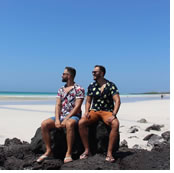 Ecuador has been for many years one of the world’s most amazing destinations for travelers from all over the globe. It’s beauty, history, culture and the Galapagos Islands have made Ecuador one of the top destinations in the planet. Let yourself be amazed by its culture expressed majestically in its churches, buildings and heritage cities. In Quito, discover the Best Preserve Historic Center in South America. Very much an up and coming city, here you'll find great culture, nightlife and a growing gay scene. Ecuador is one of these destinations that everyone should visit at least once in a lifetime. Ecuador has been for many years one of the world’s most amazing destinations for travelers from all over the globe. It’s beauty, history, culture and the Galapagos Islands have made Ecuador one of the top destinations in the planet. Let yourself be amazed by its culture expressed majestically in its churches, buildings and heritage cities. In Quito, discover the Best Preserve Historic Center in South America. Very much an up and coming city, here you'll find great culture, nightlife and a growing gay scene. Ecuador is one of these destinations that everyone should visit at least once in a lifetime.
Fly to Galapagos and board a first class private yacht to start your exploration of the archipelago, its volcanic landscapes, mangroves, amazing fauna, and natural and historical landmarks. Galapagos biodiversity is famous worldwide, from dragon-looking iguanas to the most beautiful birds on the planet.
Visit a unique volcano crater, experiment with gravity, put one foot on each side of the Equator Line, and enjoy a welcome dinner with a breathtaking view. Experience Quito’s colonial charm and architecture, enjoy a luxurious lunch, touch the sky in a gondola lift, and dine while you ride around the city.
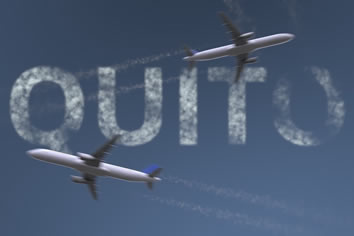
Arrive to Quito’s International Airport (UIO), be greeted by our team, and transfered to your hotel.
• Arrival to Quito
Quito is the capital and the
largest city in Ecuador (population: 2.7M). At 9,350 ft. above sea level it’s the highest (constitutional) capital city in the world.
Quito’s "Mariscal Sucre" International Airport (UIO) is one of the busiest and most efficient airports in South America. It’s located about
11 miles from the city.
• Welcome to Quito:
Our team will welcome you and assist you to the hotel (a short 5-minute shuttle ride). The highly-rated Holiday Inn Express Quito Airport Hotel awaits you for a restful first night in Ecuador, in preparation for your early flight
to Galapagos tomorrow morning. Our team will assist you with check-in. awaits you for a restful first night in Ecuador, in preparation for your early flight
to Galapagos tomorrow morning. Our team will assist you with check-in.
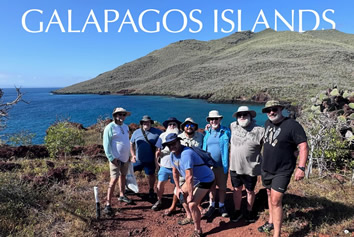
Fly to the Galápagos, get settled in your upper deck cabin, and start your exploration.
• Flight to Baltra Island, Galapagos:
Early in the morning, we will take the hotel’s shuttle to the airport for your flight to Baltra Island, home to Galapagos’s main airport. The total flight time will be approx. 3 hours, including a brief layover in Guayaquil. The Galapagos Islands will be your first UNESCO World Heritage site visit this trip!
• Transfer to our yacht:
Upon arrival, you will go through Galapagos
customs and meet our Naturalist Guide, who will assist the group with the transfer by land and water to the private yacht.
• Galapagos Angel Yacht:
First Class yacht “Angel” was built in 2023 in the Netherlands and is the newest and most luxurious ship our bear groups have ever sailed in! This vessel was designed with the elegance of classic Europe, is equipped with hydraulic stabilizers for smooth navigation, and features amenities that provide a comfortable and luxurious sailing experience at sea. Our ship is chartered exclusively for our group. With two large suites and six convertible cabins, the accommodations can comfortably accommodate 16 men of all sizes and ages.
• Santa Cruz Island:
After a short briefing session onboard and lunch, we’ll visit the highlands of Santa Cruz and see the Galápagos giant tortoise in its natural surroundings. Explore the area and its incredible underground lava tunnels – some
are more than 0.6 miles long! Wander along the volcanic tubes and keep an eye out for the (mainly) nocturnal barn owls that sometimes roost here. Dinner onboard, next day briefing session, and first night onboard our private yacht.
Highlights:
Land & marine iguanas, frigatebirds, blue-footed boobies, sea lions; snorkeling: rays, reef shark, fish, garden eels.
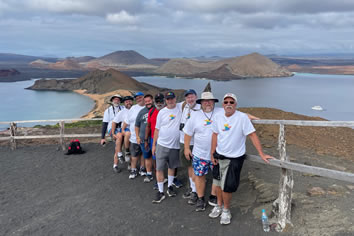
• Santiago Island: Chinese Hat Islet
This small islet is located near the southeast coast of Santiago Island. Its name comes from the distinct shape of the islet's summit. This small islet is a great location to view many geological formations such as lava tubes and lava flows.
• Lunch onboard.
• Santiago Island: Sullivan Bay
A coral beach landing leads you towards a lava field as far as the eye can see. Hunt and peck over the two distinguished types of lava, pahoehoe and 'a'a, for signs of plant life that have managed to emerge over the past 100 years since the most recent volcanic explosion. A truly amazing volcanic experience…up close and personal!
• Dinner onboard and next day briefing session.
Highlights:
Variety of lava formations and landscapes, pahoehoe lava which is found primarily in Hawai'i and the Galapagos islands, 'a'a lava, and pristine coral sand beach
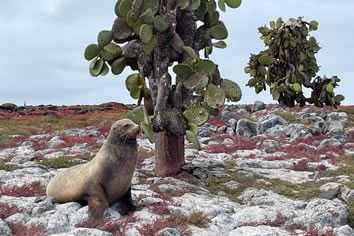
• Genovesa: Darwin Bay
This white sand coral beach heads a half mile trail (0.75km) that winds through mangroves filled with land birds. Nazca boobies, red-footed boobies, and swallow-tailed gulls can be spotted here. Further down the path are tidal pools where sea lions swim playfully. At the end is a spectacular view off a cliff.
Highlights:
Nazca boobies, red- footed boobies, swallow-tailed gulls, mangroves, coral pebbles beach, snorkeling: rays, colorful reef fish and hammerhead sharks
• Lunch onboard.
• Genovesa: El Barranco
Also known as Prince Phillip's Steps, El Barranco’s steep, rocky paths leads up to a high cliff-face. A marvelous view can be appreciated from here. This site is also home to palo santo vegetation as well as red-footed boobies, short-eared lava owls, Galapagos swallows, and Galapagos doves.
• Dinner onboard and next day briefing session.
Highlights:
Red-footed boobies, short-eared lava owls, storm-petrels, Galapagos doves
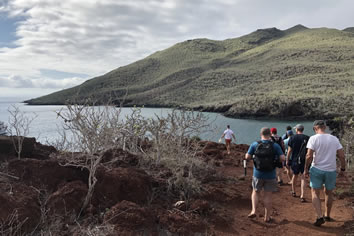
• Santiago Island: Egas Port
Also known as James Bay, Egas Port is home to the curious Galapagos hawks and quick-footed Galapagos lava lizards. The trail leads to a coastline with gorgeous tide pools and grottos full of fauna. Here the Galapagos fur sea lions bathe in the sun. This is also a great snorkeling site.
Highlights:
Fur sea lions, Galapagos sea lions, tidal pools and “grottos”, Galapagos hawk, oyster catchers, marine iguanas, finches; snorkeling: reef sharks, turtles, rays, nice underwater formations.
• Lunch onboard.
• Rabida Island
Rabida Island (Jervis) is one of the most colorful and volcanically varied islands in the archipelago and a great snorkeling site. Its famous maroon sandy beach and stunning lookouts provide wonderful landscapes. The island is a birdwatcher’s delight. Some of the rarest species are in abundance, such as nine varieties of finches, large-billed flycatchers, Galapagos hawks and brown pelicans. • Dinner onboard, next day briefing session and farewell ceremony. Last night onboard
Highlights:
Snorkeling: white-cheeked pintail ducks, colorful fish, sea lions, brackish water lagoon, penguins, Galapagos hawk
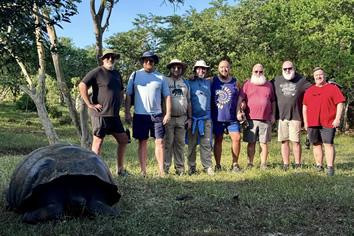
• Santa Cruz: Tortoise Breeding Center
The Charles Darwin Research Station is home to turtles ranging from 3-inches (new hatchlings) to 4-feet long. Subspecies of turtles interact with one another and many of the older turtles are accustomed to humans stretching out their heads for a photo opportunity. The babies are kept until they are about four years old and strong enough to survive on their own.
Highlights:
Giant tortoises in captivity
• Flight to Quito:
Short ride to the Baltra Airport, where we will disembark and transfer to the airport for our flight back to Ecuador mainland. At the airport you will have time to have lunch on your own and access wifi before boarding your flight to Quito (approx. 3 hours, including a quick layover in Guayaquil).
• Arrival to Quito:
Upon arrival to Quito board your international flight home. Our team will welcome again travelers heading to Machu Picchu and transfer you in private transportation to the beautiful and strategically-located Swissotel Quito by Accor near Downtown Quito awaits with complimentary high speed wifi, in-room coffee and tea, a plush duvet, Egyptian cotton linens, and electric curtains. Our team will assist with check-in upon arrival.
• If you feel like leaving the hotel for dinner, some of Quito’s best restaurants are located at walking distance (we will provide a list of recommendations). If you’d rather stay in, enjoy the hotel’s restaurants or just kick back and order room service while you rest.
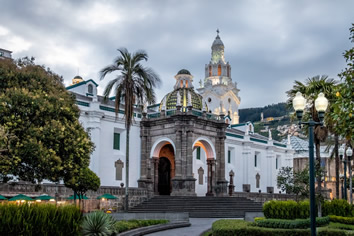
Experience Old Town’s colonial charm and architecture during the day, and end your first full day in Quito with a breathtaking view.
• Enjoy the breakfast buffet at the hotel at your leisure starting at 6:30 The Old Town tour starts around 9am.
• Quito’s Old Town:
Quito was the first city to be declared a UNESCO World Cultural Heritage Site because it has the largest, least-altered and best preserved historic center in the Americas. In 2019’s World Travel Awards, Quito won the 1st
place for Cultural Destination in South America!
• The Basilica of the National Vow:
known as La Basilica, is the most important work of neo-Gothic Ecuadorian architecture and is one of the most representative of the Americas. It is the largest neo-Gothic basilica in the New World. The building is noted for its grotesques in the form of native Ecuadorian animals such as jaguars, armadillos, iguanas, and Galapagos tortoises.
• Plaza Grande:
La Plaza de la Independencia (or Plaza Grande) is the principal square of Quito where the Presidential Palace, City Hall and Cathedral are located.
• You will enjoy a typical light lunch in Cafeteria San Agustin, the oldest eatery in Quito founded in 1858 (included). For those of you wanting something sweet, save room for a pastry and/or a hot beverage at República del Cacao Café (not included).
• The Church of the Society of Jesus:
known as La Compañía, is a Jesuit church best-known because of its large central nave, which is profusely decorated with gold leaf, gilded plaster and wood carvings. This is one of the most significant works of Spanish Baroque architecture in South America. It is Quito’s most ornate church and (according to many) the country's most beautiful.
• Church and Monastery of St. Francis:
commonly known as “San Francisco“, is a 16th-century Roman Catholic complex. It fronts onto its namesake Plaza de San Francisco. The imposing structure has the distinction of being the largest architectural ensemble among the historical structures of colonial Latin America. The style evolved over almost 150 years of construction through earthquakes and changes in artistic fashion.
• Virgin of El Panecillo:
A 45-meter-tall stone monument of a madonna which was assembled on a high pedestal on the top of Panecillo hill. Locals claim that she is the only one in the world with wings like an angel. This hill and the virgin can be seen from anywhere in Quito’s Historic Center.
• Free evening.
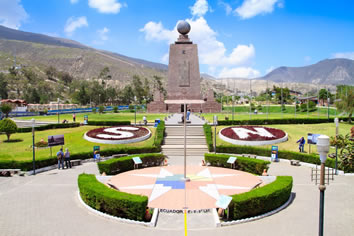
Ride a gondola lift to touch the sky, visit a unique volcano crater, put one foot on each side of the Equator Line, and enjoy dinner at one of the World’s best restaurants!
• Enjoy the breakfast buffet at the hotel at your leisure starting at 6:30 The Old Town tour starts around 9am.
• Teleferiqo (weather permitting):
this gondola lift runs from the edge of the city centre up
the Pichincha Volcano. It’s one of the highest aerial lifts in the world, rising from 10,226 to 12,943 ft. The ascent takes about 20 mins. and is rewarded with the most amazing cloud-high views of Quito and the surrounding mountains, volcanoes and sky- capped peaks.
• Intiñan Museum:
This onsite museum located right on top or the Equator Line features interactive exhibits on how the Incas determined the middle of the Earth, plus interesting science experiments such as balancing an egg on a nail and the effects of the Coriolis force on earth. Pululahua Crater (weather permitting): is one of only two volcanic craters inhabited in the world, and the only one that is farmed. The land here is extremely fertile because it is volcanic soil. The caldera of this extinct volcano is approximately 3 miles wide, one of the largest volcanic craters in the planet. Middle of the World City: The grounds of this "city" contain the Monument to the Equator, which highlights the exact location of the Equator (from which the country takes its name) and commemorates the 18th century Franco-Spanish Geodesic Mission which fixed its approximate location. The complex includes museums, interactive exhibits, shops, and a restaurant where we will have lunch. Around 4pm we will ride back to the hotel in Quito.
• At 7pm, we will meet again for our dinner, a unique gastronomic experience at Nuema, Ecuador’s only restaurant in the World’s Top 50, co-owned by the World’s Best Pastry Chef of 2023. You will be delighted with a tasting menu made exclusively with ancestral ingredients from all over Ecuador.
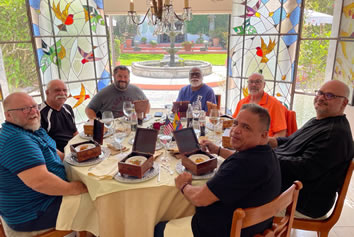
Time to say goodbye to Quito. The adventure continues towards Galapagos.
• Breakfast buffet at hotel and check-out. Transfer to Quito’s airport for your flight to Galapagos.
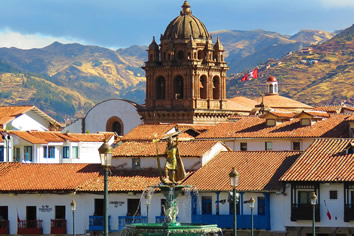
Flight to Lima and connection to Cusco. Optional gastronomic experience for dinner.
• Quito to Lima flight not included, book on your own. Upon your arrival to Lima’s International
Airport, you will be welcomed by our local representative, who will assist you with check-in for your connecting domestic flight to Cusco (included).
• Upon arrival to Cusco’s airport, you’ll be driven in private transportation directly to the beautiful Novotel Cusco Hotel, located right in the center of Historic Cusco, a couple of blocks away from Plaza de Armas (main square).
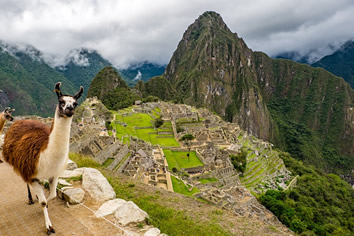
Finally the day has arrived to visit the majestic Historic Sanctuary of Machu Picchu, one of the World’s Wonders. Take it all in and feel the energy of the Incas in every step.
• After an early buffet breakfast, you will be taken to the Ollantaytambo train station. The comfortable Vistadome train ride to the station at Machu Picchu Pueblo (also known as Aguas Calientes) is packed full of spectacular vistas. On our arrival, we will take a bus that will drop us at the admission fee to the citadel of Machu Picchu itself. Unearthed for modernity by Hiram Bingham more than a century ago, Machu Picchu is considered one of the seven wonders of the world. Its architectural beauty, spectacular natural setting, and the energy that radiates from its enigmatic buildings will take your breath away. We will follow in the footsteps of the ancient Incas as we take a tour of the magical citadel led by one of our guides.
• Buffet lunch at Tinkuy Restaurant, located in the luxurious Belmond Sanctuary Lodge, feet away from the Citadel (included).
• Short bus ride back to Aguas Calientes and
the train station to catch the Vistadome train to Poroy Station in Cusco. Private transfer back to Novotel Cusco Hotel.
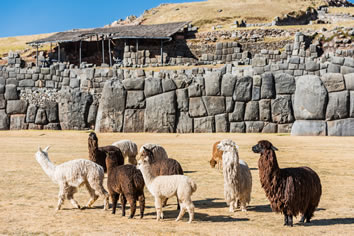
Half-day tour of Cusco, the Imperial City and quaint epicenter of impressive Incan sites like Sacsayhuaman and Qoricancha. Fly back to Lima to rest and enjoy a free evening in the gastronomic capital of Latin America.
• Buffet breakfast at the hotel. At the scheduled time we will start the exploration of the nearby ruins: the fortress of Sacsayhuaman, a colossal structure of enormous stones, carved and fitted together with incredible precision; Qenqo, the religious center; and then you will enjoy a panoramic view of Puca-Pucara, the red fortress.
• Afterwards, our tour continues in the Imperial City, we will stroll through the Main Square of Cusco, where we will visit the Cathedral and admire its exquisite vestibules and priceless paintings from the Cusco School of the 17th and 18th centuries.
• For lunch, the group will be taken to Pachapapa, a popular local restaurant famous for their "cuy" (guinea pig) for those who want to try it, or you can order something else from their extensive traditional menu. This meal is not included.
• We will continue with a visit to one of the most impressive buildings of Incan Cusco: Qoricancha (the Golden Temple) - a temple dedicated to the worship of the Sun God, whose interior walls were said to have been covered in gold.
• At the appropriate time private transfer to the airport for your flight back to Lima (included).
• Upon arrival, transfer to the Aloft Lima Miraflores hotel (40-60 minute drive). After check-in, enjoy dinner on your own at one of Lima’s best-in-the-world restaurants, or take advantage of convenient options like eating at the hotel’s
bar, or next door at Mercado 28, a nice food court open until 11pm with several Peruvian staples and international food vendors.
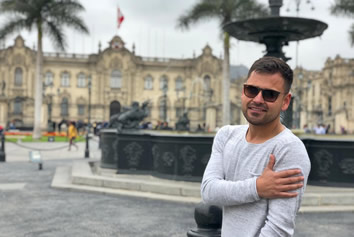
Enjoy the architecture, art and culture of colonial Lima and its different districts before heading back home full of memories of the trip of a lifetime!
&bullAfter buffet breakfast at the hotel, we will head to Pueblo Libre district to visit to the Larco Museum, an eighteenth-
century Viceregal mansion that houses more than 3,000 years of Peru's pre-Columbian history. The museum boasts a supremely fine collection of gold and silver jewelry and worship paraphernalia that demonstrates the superb skill of ancient Peruvian gold and silversmiths. The Larco Museum also contains a famous collection of erotic ceramic tomb art that gives insights into various aspects of pre-Columbian sexuality. The visit will
be greatly enriched by the curator of the Museum, who will provide in-depth explanations and serve as a unique conduit to the past. All areas are
illuminated to showcase the beauty the museum’s pieces.
• Lunch at Café del Museo.
• After lunch, we will continue our tour to the Colonial City of Lima. First, we will stop off at the Main Square, to explore it on foot and admire the exteriors of the Government Palace, the Cathedral, and the City Hall, all examples of Lima's still-present colonial architectural opulence. We will visit the Cathedral; as walking through its numerous chapels, we will discover various architectural styles and learn about the religious history of Peru. We will continue with the visit to Casa de Aliaga, a colonial mansion that currently holds the distinction of being the oldest continuously inhabited private residence in the Southern Hemisphere. Finally, we will begin a journey
through the streets of modern Lima as head toward the most traditional of the residential zones of the capital: San Isidro, the heart of
the city's financial district; and Miraflores, a perfect spot to enjoy wonderful views of the Pacific Ocean.
• In the late afternoon, private transfer to the airport to take your international flight back
home. This concludes our services and put an end to Bearlapagos 2025 and a fantastic
14-day trip to Ecuador and Peru. Thank you!
• If you’re ready to start your adventure, book today, spaces are limited!
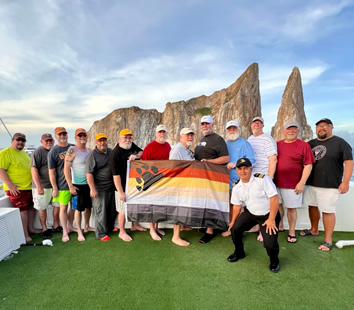
|
|
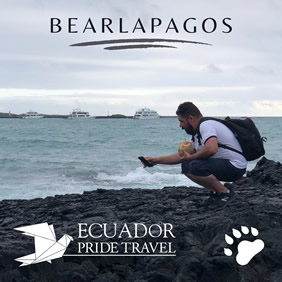
• 2 nights accommodation in 5-star hotel in Quito, with free Wifi and breakfast buffet
• 1 night accommodation in airport hotel in Quito, with free Wifi and breakfast buffet
• Most meals are included in the itinerary. Soft drinks / coffee are included with all meals
• Private transportation with A/C, complimentary soft drinks and snacks
• English-speaking private gay tour guide and Tour Leader (available 24/7)
• $20 transit card, which has to be paid individually by each passenger to the authorities, in cash, before we board the plane to Galapagos
• Complimentary travel assistance up to US$50,000 for the Ecuador/Galapagos portion of your trip
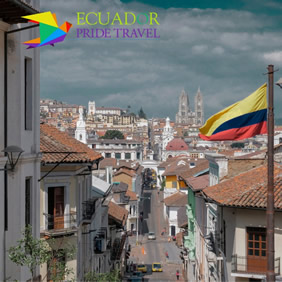
• Airfare Quito-Galapagos-Quito (valued at $500+)
• $200 entrance fee to the Galapagos National Park, which has to be paid individually by each passenger to the authorities, in cash, at the airport when we land in Galapagos
• 5 days and 4 nights in a cabin for 2 with private bathroom, A/C and windows facing the ocean. The Angel Yacht is a privately-owned vessel with a capacity for 16 passengers, the full ship is only for our group
• 3 meals per day; snacks after all excursions; unlimited water, tea, coffee
• Naturalist English-speaking guide
• Airport-to-dock transportation and vice versa
• Water transportation to excursion sites
• Snorkeling equipment available
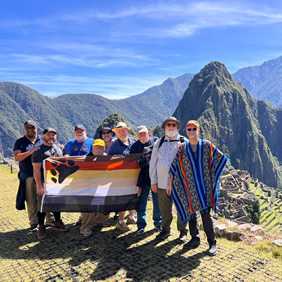
• 2 nights accommodation in boutique hotel in Cusco with breakfast
• 1 night accommodation in 4-star hotel in Lima with breakfast
• Domestic airfare Lima-Cusco-Lima
• Vistadome (train) and bus tickets to/from Machu Picchu
• Entrance fees to Machu Picchu
• Private ground transportation
• English-speaking private tour guide
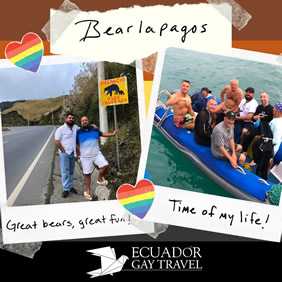
• Your international airfare to/from Quito.
• International flight from Quito-Lima
• Hotel and airline upgrades - if available
• Meals and activities not mentioned in the itinerary
• Alcoholic beverages
• Tips for boat crew and tour guides.
• Tour extension to Peru (Machu Picchu, Cusco and Lima)
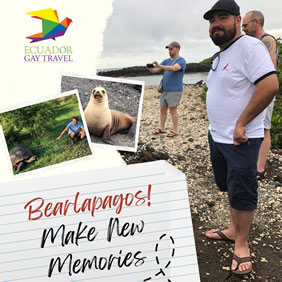
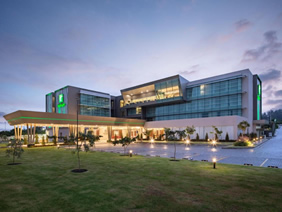 
Holiday Inn Express Quito Airport Hotel , Quito , Quito
Holiday Inn Express Quito Airport Hotel located just five minutes from Quito Mariscal Sucre International Airport, and 30 minutes from the north of the city, where the main corporate offices and the biggest shopping centers are located.
The city’s classic touristic attractions such as Mitad del Mundo and Quito Downtown are located 45 minutes away.
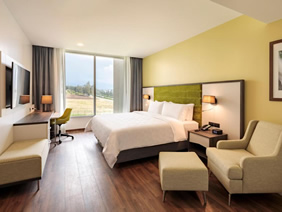
Holiday Inn Quito Airport offers 125 comfortable rooms distributed between King, Doubles, Suites, Executive and Handicap. An elegant Executive Lounge with a panoramic view of the surrounding mountains is available for you.
A heated outdoor pool with hydromassage, Turkish bath and comfortable changing rooms are ideal to enjoy with the family or plan a special event. Our spa and 24-hour Gym will take care of your body and mind.
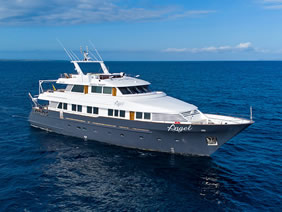
Galapagos Angel Yacht, Galapagos
First Class yacht Angel was built in 2023 in the Netherlands and is the newest and most luxurious ship our bear groups have ever sailed in! This vessel was designed with the elegance of classic Europe, is equipped with hydraulic stabilizers for smooth navigation, and features amenities that provide a comfortable and luxurious sailing experience at sea.
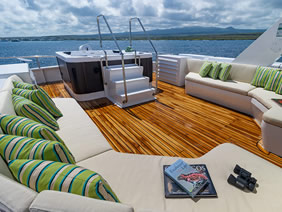
Our ship is chartered exclusively for our group. With two large suites and six convertible cabins, the accommodations can comfortably accommodate 16 men of all sizes and ages.
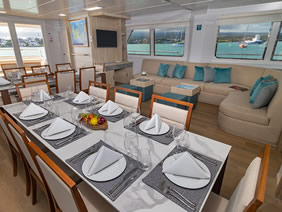
A once in a lifetime experience both on the trails and onboard! Cruising the Galapagos islands is an unforgettable experience because of its unique and close encounters with its amazing wildlife. The cherry on top is to enjoy from this privilege in a small more personalized cruise setting.
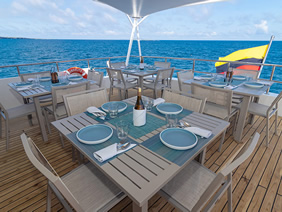
Experiencing the Galapagos Islands on a small 16 passenger yacht is an added value that will make your cruise unforgettable. In a more intimate setting, you will be sharing your Galapagos adventure with few other guests that share the same belief that cruising on a small cruise boat has less impact on the Galapagos ecosystem while benefiting from a more personalized service. Our crewmembers will go above and beyond to make your experience of the Galapagos unforgettable.
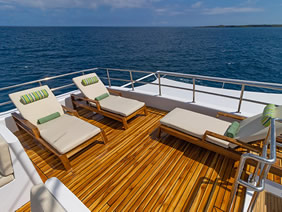
While onboard, all meals are included, as well as snacks after excursions and water/coffee/tea. Onboard facilities include indoor and outdoor dining, bars, lounging areas, and a sundeck with loungers and a hot tub to relax in after the daily excursions. The use of snorkeling and excursion gear is included. And with free onboard WiFi service you can share your day-to-day adventures with the world in real time!
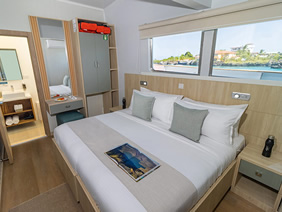
Our kitchen staff will keep you pampered while you are onboard. From delicious hot/cold snacks waiting for you after your morning and afternoon explorations, to mouthwatering hot lunches and dinners, the Angel has you covered
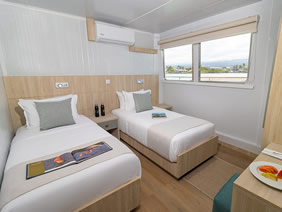
Our barman/waiter together with our Chef and his assistant will make sure you experience the best from the Ecuadorian and international gastronomy. Your day will start with an ample breakfast spread in the mornings right before your morning landing. Upon your return from your visits to the islands both in the morning and on the afternoon, you will find hot/cold snacks with a refreshing fruit juice. Coffee and hot water for your favorite tea will be available 24 hours.
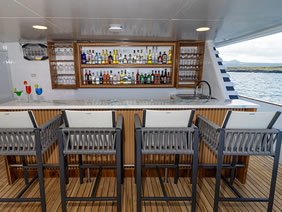
Our Barman can help quench your thirst with a cold beer or cater to your palette with our selection of wines. Spirits and cocktails are also available. Be sure to ask our barman for our Galapagos inspired cocktail!
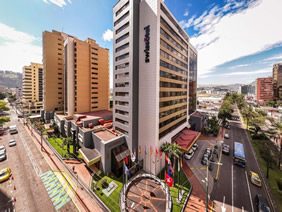
Swissotel Quito Hotel, Quito
Swissôtel offers elegant accommodations in Quito’s affluent commercial and residential district. It features 2 pools, tennis and squash courts, as well as a spa with hydromassage tub and massage treatments. Free Wi-Fi is available.
Featuring wood accents and Egyptian cotton linens, rooms at Swissôtel Quito are bright, air conditioned and equipped with free Wi-Fi access. They all come with cable TV channels, mini-bar and in-room safe.
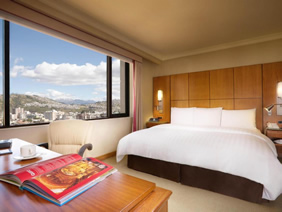
Five on-site restaurants offer a range of dishes from renowned French, Swiss and Japanese culinary traditions. The hotel’s modern meeting and event center is one of the largest in the city.
Quito’s Old Town district is 1.9 mi from the Swissôtel and is the most intact in South America, according to UNESCO. Mariscal Area is popular with expats for its clubs and bars and is a 15-minute drive away.
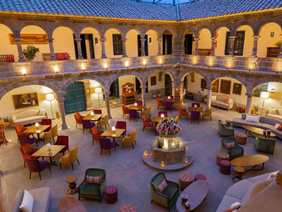
Novotel Cusco Hotel, Cusco (Peru)
Novotel Cusco has a nice colonial atmosphere with modern touches, adding to your experience. Situated in a 16th century building in Cusco, Novotel Cusco offers modern rooms with heating and cable TV. It is only 3 blocks from Plaza De Armas and the cathedral.
All rooms of Cusco Novotel are equipped with a minibar, a work desk, and a private bathroom. Some rooms have a flat-screen TV. Room service is available 24/7.
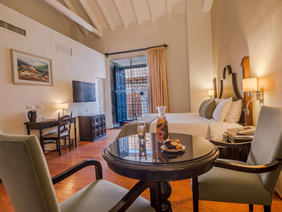
Guests can enjoy international and local cuisine in La Cave Restaurant, or on the heated patio covered with a spectacular glass ceiling. The bar serves a wide variety of drinks and snacks. Additionally, guests can also enjoy Le Cote Jardin 365, the hotel's other restaurant. The public computers of Novotel Cusco have free WiFi. The hotel also offers a 24-hour reception, and a tour desk.
Novotel Cusco is just 3 blocks from the Historic Center, a heritage of the country. Admire the Plaza de las Armas, Cathedral of Cusco and visit the ruins of Sacsayhuaman, just 12 minutes from the hotel. Novotel Cusco offers easy access to anywhere in the city. Beautiful architecture preserves history and adds comfort and modernity to your stay.
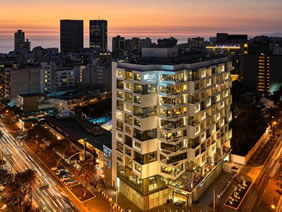 
Aloft Lima Miraflores Hotel , Lima (Peru) , Lima (Peru)
This property is 20 minutes walk from the beach. Designed for citizens of the world that likes open spaces, are sociable and for who possibilities are created by travels. Aloft Lima Miraflores combines music, design, and technology to provide a unique experience to its guests. Aloft Lima Miraflores offers industrial aesthetics, of urban inspiration, a sophisticated sense of design and a smart and flexible use of spaces.
Aloft Lima Miraflores is located on Av. 28 de Julio, one of the best areas of the city. Next to it, you can find Balboa Strip Mall, which has a great gastronomic offer and various fashion stores. In addition, you will be close to the best coffee shops, nightlife, the Larco Mar shopping center and the bohemian district of Barranco. It is just a few blocks from the Miraflores boardwalk.
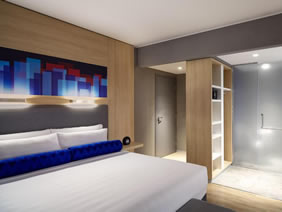
The hotel offers 164 guest rooms, free Wi-Fi throughout all of the hotel, an indoor heated pool next to a terrace to relax while enjoying a signature cocktail, a 24/7 gym to have a daily energy recharge. Re:Fuel, a healthy food station and a 24/7 Gourmet Grab & Go that will delight even the most demanding tastes. At W xyz Bar you will find from signature cocktails that are renewed constantly to Peruvian cocktail classics. Re:Mix lounge is the place where our guests can "work and play", the perfect space during the day to host business meetings in our Tactic meeting rooms that can accommodate up to 80 people, and at night it is a fun place full of life to enjoy live band's performances.
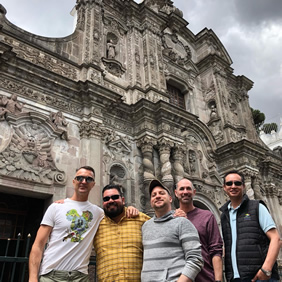
|
|